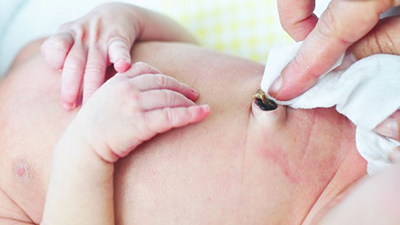 Welcoming a newborn baby is a moment of excitement for most parents. Despite the great joy accompanying the newest family member, many things need to be taken care. In particular the young and first time parents.
Welcoming a newborn baby is a moment of excitement for most parents. Despite the great joy accompanying the newest family member, many things need to be taken care. In particular the young and first time parents.
In this article, I would like to share a bit about caring for a newborn’s belly button. But first, let us get a rough picture of the origin of the belly button.
What is the ‘umbilical cord’?
The umbilical cord plays an important role when the baby is in the womb. The cord begins to form at the fifth week of gestational age. This cord is connected to the placenta and functions to convey nutrient and oxygen rich blood to the fetus while it’s growing and developing in the mother’s womb. Deoxygenated blood from the fetus is then returned to the placenta via the umbilical cord. The umbilical cord is thus the ‘lifeline’ of the fetus.
What happens when the baby is born?
When the baby is born, the umbilical cord is no longer needed. A few moments after the baby is safely out, the umbilical cord which is attached to the placenta will be clipped using a cord clamp to avoid the blood from the placenta to flow continuously into the baby. Otherwise, there might be too much blood flowing into the baby’s circulatory system leading to many other complications. The cord is later severed so that the baby is detached from the placenta. The baby does not feel pain because there are no nerve endings in the umbilical cord.
It is essential that the umbilical cord be cut with a sterile instrument. Using rusty razor blades or scissors can lead to dangerous neonatal tetanus infection. Neonatal tetanus isno longer found in communities practicing safe birth methods. However, we still encounter neonatal tetanus cases in our country due to unhygienic deliveries and cord care practices.Tali pusat yang ada pada bayi akan menjadi kering, berubah warna dan mengecut. Kebiasannya tali pusat yang telah kering itu akan jatuh dengan sendirinya dalam masa 2 minggu. Maka tinggallah struktur yang kita kenali sebagai ‘pusat’ pada permukaan perut bayi. Pusat ini pula mengambil masa antara 5 hingga 7 hari untuk kering sepenuhnya.
The umbilical cord stump on the baby will dry out, discolor and shrink. Usually, it takes the dry stump 2 weeks before falling off on its own. What remains is the structure we know as the belly button on the surface of the baby’s tummy. The belly button will take 5 to 7 days to fully dry..
How to care for the baby’s belly button?
- Usually, parents will be given some ‘alcohol solution’ or ‘antiseptic’ to clean the stump. However, there are some data saying that cleaning the stump with clean water followed by adequate drying is already sufficient. Nevertheless, in some cases, alcohol and antiseptic are still required. So, do have this conversation with the doctor if you have questions.
- When putting on diapers, make sure the stump is not covered. Place the stump outside the diapers so that it is not soiled or affected by the baby’s urine. This will help the stump to dry.
- Talcum powder or any traditional preparation is unnecessary as it can interfere the natural falling process of the stump. Clean water is sufficient.
- When the stump is still attached, bathes the infant by wiping her using a wet cloth or by pouring water over. These are recommended rather than immersing the infant, leaving the stump under water for a period of time. The stump can be wiped dry after the baby is bathed.
- Refrain from pulling the stump off even when it seems to come off at any time soon. Let nature take its course.
Signs of navel infection
Chances are the belly button is infected if these signs are present:
- The surrounding skin is reddish.
- Presence of pus, blood or foul smell at the navel.
- The infant is feverish, less active and not suckling.
Go for a check-up at the doctor’s
If you see any suspicious signs at the stump/navel as stated above, do bring your infant to the hospital quickly to get it checked and further treatment. An untreated infection at the belly button can cause dangerous blood infection in the baby. See a medical practitioner if there is still bleeding at the navel stump or the stump has not fall off after 3-4 weeks.
Dr. Alya Hamzah is a pediatrician working in Selangor and currently preparing for her post-graduate pediatrics examination. She believes that the patient and the doctor should travel the road to better health together. Get to know her more at ‘The Team’ page.
[This article belongs to The Malaysian Medical Gazette. Any republication (online or offline) without written permission from The Malaysian Medical Gazette is prohibited.]
